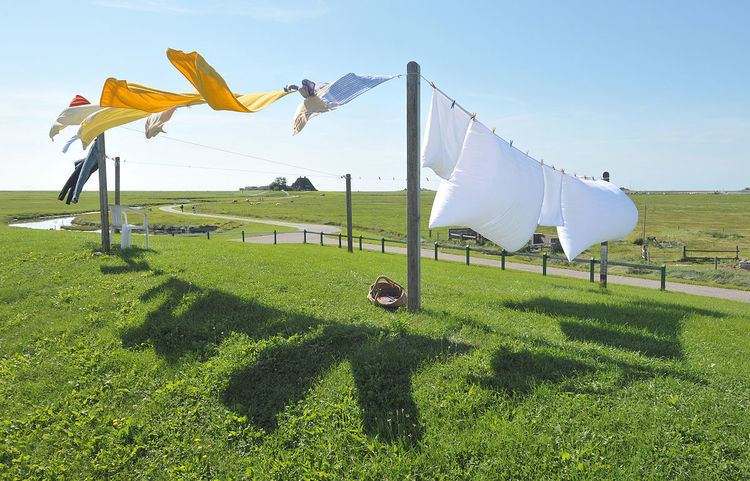 | ||
A clothes line or washing line is any type of rope, cord, or twine that has been stretched between two points (e.g. two sticks), outside or indoors, above the level of the ground. Clothing that has recently been washed is hung along the line to dry, using clothes pegs or clothespins. Washing lines are attached either from a post or a wall, and are frequently located in back gardens, or on balconies. Longer washing lines often have props holding up sections in the middle due to the weight of the usually wet clothing.
Contents
- Advantages
- Disadvantages
- Drying laundry indoors
- Factors that determine the drying duration
- Drying laundry in freezing conditions
- Controversy in North America
- References
More elaborate rotary washing lines save space and are typically retractable and square or triangular in shape, with multiple lines being used (such as the Hills Hoist from Australia). Some can be folded up when not in use (although there is a very minor hazard of getting fingers caught, so there is usually a safety button).
In Scotland, many tenement buildings have a "drying green", which is a communal area predominantly used for clothes lines – it may also be used as a recreational space - as well as a clothes horse connected to a pulley system inside which can be used in the frequently cold winter weather.
Advantages
Disadvantages
Drying laundry indoors
Laundry may be dried indoors rather than outdoors for a variety of reasons including:
Several types of devices are available for indoor drying. A drying rack or clotheshorse can help save space in an apartment, or clothes lines can be strung in the basement during the winter. Small loads can simply be draped over furniture or a shower curtain pole. The drying time indoors will typically be longer than outdoor drying because of the lack of direct solar radiation and the convective assistance of the wind.
The evaporation of the moisture from the clothes will cool the indoor air and increase the humidity level, which may or may not be desirable. In cold, dry weather, moderate increases in humidity make most people feel more comfortable. In warm weather, increased humidity makes most people feel even hotter. Increased humidity can also increase growth of fungi, which can cause health problems.
An average-sized wash load will convert approximately 4965 kilojoules of ambient heat into latent heat that is stored in the evaporated water, as follows. A typical 4 kg load of laundry can contain 2.2 kg of water, after being spun in a laundry machine. To determine how much heat has been converted in drying a load of laundry, weigh the clothes when they are wet and then again after the clothes have dried. The difference is the weight of the water that was evaporated from them. Multiply that weight in kg by 2,257 kJ/kg, which is the heat of vaporization per kilogram, to obtain the number of kilojoules that went into evaporating the water, or multiply by 0.6250 kWh/kg to get kilowatt-hours. (Note: If the moisture later condenses inside the house, the latent heat will be converted back into ambient heat which could increase the temperature of the air in the room slightly.) To obtain a good approximation of the effect this would have in a particular situation, the process can be traced on a psychrometric chart.
Factors that determine the drying duration
Various factors determine the duration of drying and can help to decide rather to use a drier or a clothes line
Drying laundry in freezing conditions
Laundry may be dried outdoors when the temperature is well below the freezing point. First, the moisture in the laundry items will freeze and the clothing will become stiff. Then the frost on the clothes will sublimate into the air, leaving the items dry. It takes a long time and it is usually much quicker to dry them indoors; however, indoor drying removes heat from the air so it is a trade-off between speed and energy efficiency.
Controversy in North America
Controversy surrounding the use of clothes lines has prompted many governments to pass "right-to-dry" laws allowing their use. According to Ian Urbina, a reporter for The New York Times, "the majority of the 60 million people who now live in the country’s roughly 300,000 private communities" are forbidden from using outdoor clothes lines.
As of August 2013, the states of Florida, Colorado, Hawaii, Arizona, California, Illinois, Indiana, Louisiana, Maine, Maryland, Massachusetts, Nevada, New Mexico, North Carolina, Oregon, Texas, Vermont, Virginia, and Wisconsin had passed laws forbidding bans on clothes lines, with Utah allowing local jurisdictions to forbid such bans. At least eight states restrict homeowners' associations from forbidding the installation of solar-energy systems, and lawyers have debated whether or not those laws might apply to clothes lines. A British filmmaker, Steven Lake, was planning to release a documentary in 2011 titled Drying for Freedom about the clothes-line controversy in the United States.
In Canada, the province of Nova Scotia's first NDP government passed An Act to Prevent Prohibitions on the Use of Clotheslines on December 10, 2010 to allow all homeowners in the province to use clotheslines, regardless of restrictive covenants. The province of Ontario lifted bans on clothes lines in 2008.
Some other affluent suburban municipalities such as Hampstead, Québec or Outremont, Québec also prohibit clotheslines.
